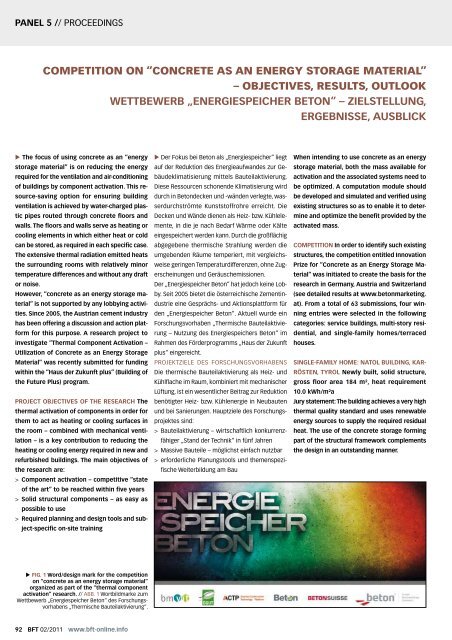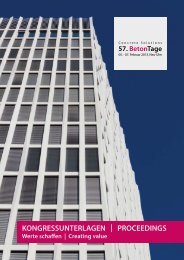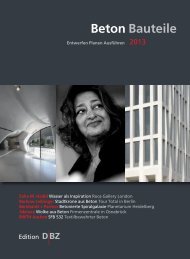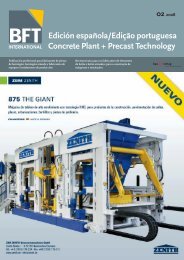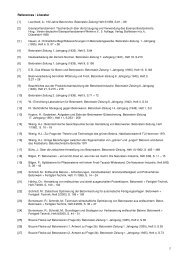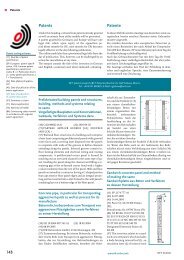Tagungsband - BFT International
Tagungsband - BFT International
Tagungsband - BFT International
Erfolgreiche ePaper selbst erstellen
Machen Sie aus Ihren PDF Publikationen ein blätterbares Flipbook mit unserer einzigartigen Google optimierten e-Paper Software.
PANEL 5 // PROCEEDINGS<br />
� The focus of using concrete as an “energy<br />
storage material” is on reducing the energy<br />
required for the ventilation and air-conditioning<br />
of buildings by component activation. This re-<br />
source-saving option for ensuring building<br />
ventilation is achieved by water-charged plas-<br />
tic pipes routed through concrete floors and<br />
walls. The floors and walls serve as heating or<br />
cooling elements in which either heat or cold<br />
can be stored, as required in each specific case.<br />
The extensive thermal radiation emitted heats<br />
the surrounding rooms with relatively minor<br />
temperature differences and without any draft<br />
or noise.<br />
However, “concrete as an energy storage ma-<br />
terial” is not supported by any lobbying activi-<br />
ties. Since 2005, the Austrian cement industry<br />
has been offering a discussion and action plat-<br />
form for this purpose. A research project to<br />
investigate “Thermal Component Activation –<br />
Utilization of Concrete as an Energy Storage<br />
Material” was recently submitted for funding<br />
within the “Haus der Zukunft plus” (Building of<br />
the Future Plus) program.<br />
PROJECT OBJECTIVES OF THE RESEARCH The<br />
thermal activation of components in order for<br />
them to act as heating or cooling surfaces in<br />
the room – combined with mechanical venti-<br />
lation – is a key contribution to reducing the<br />
heating or cooling energy required in new and<br />
refurbished buildings. The main objectives of<br />
the research are:<br />
COMPETITION ON “CONCRETE AS AN ENERGY STORAGE MATERIAL”<br />
– OBJECTIVES, RESULTS, OUTLOOK<br />
WETTBEWERB „ENERGIESPEICHER BETON“ – ZIELSTELLUNG,<br />
ERGEBNISSE, AUSBLICK<br />
> Component activation – competitive “state<br />
of the art” to be reached within five years<br />
> Solid structural components – as easy as<br />
possible to use<br />
> Required planning and design tools and sub-<br />
ject-specific on-site training<br />
� FIG. 1 Word/design mark for the competition<br />
on “concrete as an energy storage material”<br />
organized as part of the “thermal component<br />
activation” research. // ABB. 1 Wortbildmarke zum<br />
Wettbewerb „Energiespeicher Beton“ des Forschungsvorhabens<br />
„Thermische Bauteilaktivierung“.<br />
92 <strong>BFT</strong> 02/2011 www.bft-online.info<br />
� Der Fokus bei Beton als „Energiespeicher“ liegt<br />
auf der Reduktion des Energieaufwandes zur Ge-<br />
bäudeklimatisierung mittels Bauteilaktivierung.<br />
Diese Ressourcen schonende Klimatisierung wird<br />
durch in Betondecken und -wänden verlegte, was-<br />
serdurchströmte Kunststoffrohre erreicht. Die<br />
Decken und Wände dienen als Heiz- bzw. Kühlele-<br />
mente, in die je nach Bedarf Wärme oder Kälte<br />
eingespeichert werden kann. Durch die großflächig<br />
abgegebene thermische Strahlung werden die<br />
umgebenden Räume temperiert, mit vergleichs-<br />
weise geringen Temperaturdifferenzen, ohne Zug-<br />
erscheinungen und Geräuschemissionen.<br />
Der „Energiespeicher Beton“ hat jedoch keine Lob-<br />
by. Seit 2005 bietet die österreichische Zementin-<br />
dustrie eine Gesprächs- und Aktionsplattform für<br />
den „Energiespeicher Beton“. Aktuell wurde ein<br />
Forschungsvorhaben „Thermische Bauteilaktivie-<br />
rung – Nutzung des Energiespeichers Beton“ im<br />
Rahmen des Förderprogramms „Haus der Zukunft<br />
plus“ eingereicht.<br />
PROJEKTZIELE DES FORSCHUNGSVORHABENS<br />
Die thermische Bauteilaktivierung als Heiz- und<br />
Kühlflache im Raum, kombiniert mit mechanischer<br />
Lüftung, ist ein wesentlicher Beitrag zur Reduktion<br />
benötigter Heiz- bzw. Kühlenergie in Neubauten<br />
und bei Sanierungen. Hauptziele des Forschungs-<br />
projektes sind:<br />
> Bauteilaktivierung – wirtschaftlich konkurrenz-<br />
fähiger „Stand der Technik“ in fünf Jahren<br />
> Massive Bauteile – möglichst einfach nutzbar<br />
> erforderliche Planungstools und themenspezi-<br />
fische Weiterbildung am Bau<br />
When intending to use concrete as an energy<br />
storage material, both the mass available for<br />
activation and the associated systems need to<br />
be optimized. A computation module should<br />
be developed and simulated and verified using<br />
existing structures so as to enable it to deter-<br />
mine and optimize the benefit provided by the<br />
activated mass.<br />
COMPETITION In order to identify such existing<br />
structures, the competition entitled Innovation<br />
Prize for “Concrete as an Energy Storage Ma-<br />
terial” was initiated to create the basis for the<br />
research in Germany, Austria and Switzerland<br />
(see detailed results at www.betonmarketing.<br />
at). From a total of 63 submissions, four win-<br />
ning entries were selected in the following<br />
categories: service buildings, multi-story resi-<br />
dential, and single-family homes/terraced<br />
houses.<br />
SINGLE-FAMILY HOME: NATOL BUILDING, KAR-<br />
RÖSTEN, TYROL Newly built, solid structure,<br />
gross floor area 184 m², heat requirement<br />
10.0 kWh/m²a<br />
Jury statement: The building achieves a very high<br />
thermal quality standard and uses renewable<br />
energy sources to supply the required residual<br />
heat. The use of the concrete storage forming<br />
part of the structural framework complements<br />
the design in an outstanding manner.


